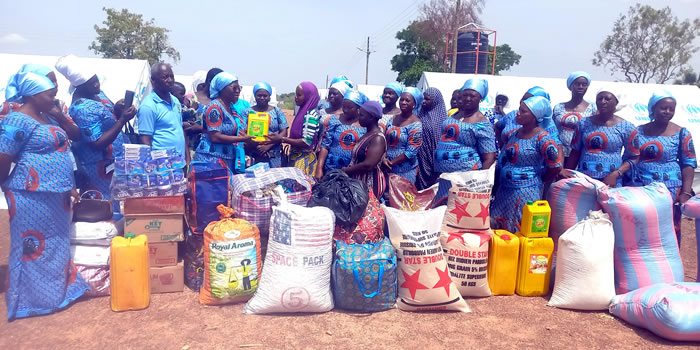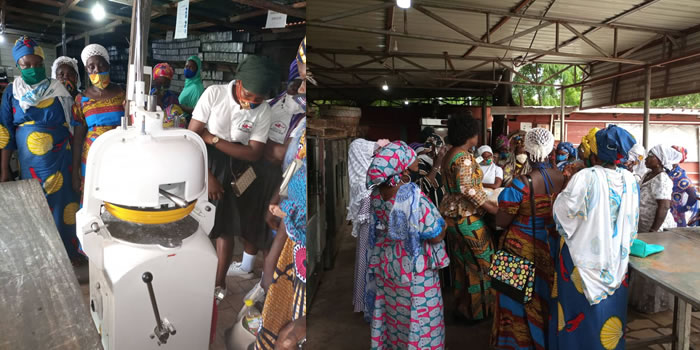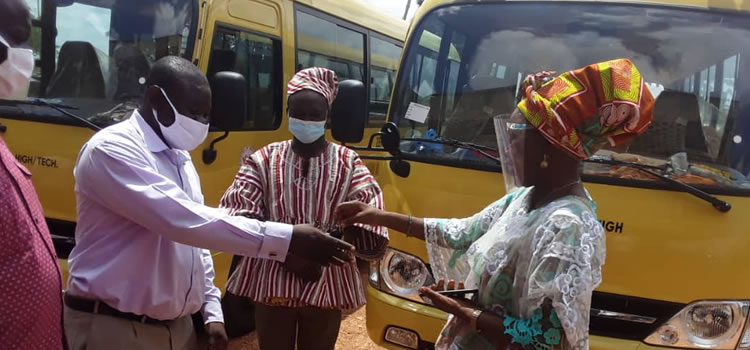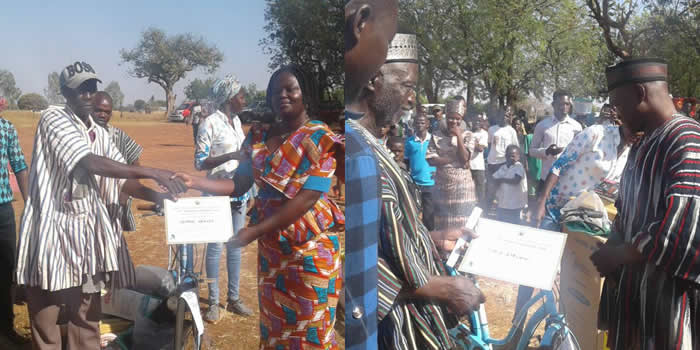

Climate
The district experiences a unimodal rainfall regime lasting 4 to 6 months and a long dry period of 6 to 8 months in a year. The average annual rainfall, temperature and relative humidity are 956mm, 34oC and 56% respectively, with potential evapotranspiration of more than 2882mm.There is therefore excessive evapotranspiration over rainfall.
Vegetation
The district’s vegetation is Sudan Savannah consisting of short drought and fire resistant deciduous trees interspersed with open savannah grassland. Grass is very sparse and in most areas the land is bare and severely eroded. Common grasses include Andropogan gayanus (Northern Gamber Grass) in the less eroded areas and Hyparhenia spp, Aristida spp, and Heteropogon spp. (Spear grass) in the severely eroded areas. Common trees include Anogeissus spp, Acacia spp (Thorn tree) and Triplochiton spp. Economic trees include Parkia filicoidea (Dawadawa), Butyrospermum parkii (Sheanut), Andansonia digitata (Baobab) and Ceiba pentandra (Kapok).
In most cases the vegetation is highly degraded by land clearing for farming, fuel wood harvesting, overgrazing, annual bushfires, and harvesting of poles for construction. The activities of illegal miners also contribute to the degradation of the vegetation in some parts of the district as most of these illegal activities take place on agricultural lands, and this therefore has serious implications on soil fertility for sustainable crop production
Relief and drainage
The relief of the district is generally flat to gently undulating. These plains are broken in some places by hills or ranges formed from either outcrops of Birimian rocks (greenstones) or granite intrusions. These ranges lie along the border with Burkina-Faso, north of Zebilla, and turn south-west from the Red Volta north of Nangodi in the Talensi-Nabdam District. The granite areas are generally low to gently rolling (120 – 255m a.s.l).
The features of the hills vary from place to place but generally they have steep rocky slopes and narrow valleys subject to high rates of runoff leading to flash floods, gully erosion and stream bank erosion.
The district is drained by both the White and Red Volta and their tributaries. The rivers over flow their banks during the rainy season (June to September) but dry up soon after the season with disconnected pools of water in their beds separated by dry stretches of sand and rocks. During the dry season, the sand bars make it possible for people to cross the White Volta on foot or by motor cycles at Sapelliga, the Ghana-Burkina-Faso border.
Soils & general characteristics
The total hectarage in the district suitable and unsuitable for crop production is 58,406 and 336,687 respectively.
The major soils mapped in the district belong to Luvisols, Lixisols, Leptosols, Gleysols and Fluvisols. Other less extensive soils include Plinthosols, Regosols, Vertisols and Cambisols.
They are developed over granites, Birimian rocks and recent and old alluvia of mixed origin. Because these parent materials are coarse textured, many of the soils have predominantly light textured surface horizons (sandy) with heavier textured soils (clayey) confined to valley bottoms. There are also extensive areas of shallow concretionary and rocky soils, which have low water holding capacities and limited suitability for agriculture.
Most of the soils, having developed over thoroughly weathered parent materials, are old and have been leached over a long period of time. Their buffering capacity as well as caution exchange capacity is also low since their predominant clay mineral is kaolinitic, consequently, most of the soils are of low inherent fertility.
The two most frequently deficient nutrients are nitrogen and phosphorus. The build-up of any amount of organic matter is constrained by regular burning of crop residues and/or competitive use of these residues for fuel, animal feed or building purposes. The low vegetative cover during the dry season also renders most of the soils susceptible to erosion during the rainy season.
This, in turn, exacerbates the low fertility problem. The sustainability of good crop yields is therefore closely linked with careful management of the soils with the objective of preventing and controlling erosion, increasing their organic matter content (compost, crop residues, farmyard manure, etc.) and replacing and increasing plant nutrients lost through erosion, leaching and crop uptake.
Geology
The soils and water supply conditions of the district are directly related to the underlying rocks. The major rocks fall within the Birimian and Granitic geological formations.
The Birimian rocks, often associated with granites, consist of steeply dipping metamorphosed sediments and volcanics. The argillaceous rocks of the Birimian formation consist, among others, of phyllites, biotite schists and quartzites, some of which are found north of Zebilla, south of Sapelliga and around Zongoyiri area.
The volcanic group consists of greenstones, hornblende schists and phyllites. The rocks occur as hill ranges found north of Zebilla (e.g. Kubongo, Widnaba and Komaka) and in Apodabogo. Deposits of gold reportedly underlie the Birimian formation north of Zebilla and south of Sapelliga. In the Widnaba-Teshie zone, illegal mining of gold (‘galamsey’) accompanied by serious land degradation is prevalent. Therefore, if the activities of these illegal miners in the district which is on the increase are not checked, further degradation of the land would have serious consequences on agricultural production and household food security in the district as most of these mining activities take 4
place on agricultural lands. This would further worsen the poverty situation in the District since more than 80% of the population depends on agriculture for their livelihoods of which women are the majority.
The granitic rocks consist mainly of biotite and hornblende complex with potassium feldspars and sodium feldspars dominant in the biotite granite and biotite granodiorites respectively. These granites are coloured pink, coarse grained and potassium rich. The soils formed from these rocks are light textured and rich in potassium.
Wildlife
The sparsely inhabited Oncho-freed woodland and forest belt and the uninhabited forest reserve along the eastern and southern portions of the Red and White Volta, stretching from Widnaba-Tilli area in the district through Binaba-Kusanaba and Zongoiri to East Mamprusi, is a favourable abode of a variety of animals including elephants. This forest belt (Eastern Wildlife Corridor) is the natural route for elephants moving to and from Burkina Faso through the district to East Mamprusi District. The forest belt with its rich flora and fauna presents an ecotourism potential in the district.
However, the wild animal resources have severely depleted and their habitats continue to be under siege from various economic activities including land clearing for agriculture, indiscriminate bush burning, hunting for bush meat, logging and mining. Community participation in the protection against encroachment and poaching and monitoring of animals in conserved areas will contribute to sustained build-up of wildlife stocks. The long-term goal is to ensure participation of the rural communities in wildlife management activities both in protected areas and outside reserve areas.
Biodiversity
The natural woodlands and forest are a rich source of plant and animal biodiversity. They also protect soil and water resources. Future efforts on improving crops will need to draw heavily on the gene pool of native/wild crop varieties.
Biodiversity conservation should aim at conserving unique species and habitats, maintaining traditional crop varieties, land races and their wild varieties and improving the livelihoods of communities.
Priority areas that are of national and global importance for biodiversity conservation should be delineated, mapped and excluded from exploitation and community-based management plans developed for the protection of these areas. There would be the need to finance alternative livelihood schemes for affected communities and provide for continuous monitoring and evaluation of biological and social indicators of programme performance.
The alternative livelihood schemes would improve the economic status of the communities living around the protected areas and encourage them to participate in the conservation programme and forgo income previously generated from the newly delineated site. This would in addition, relieve pressure on biological resources by supporting alternative development options.
Hydrology and water supply
The water supply condition in the district is directly related to the underlying rocks. Areas occupied by Birimian rocks have a high surface runoff so that surface flow of streams generally persist throughout the dry season as observed at some places such as Komaka, Kasongo and Kubongo. The rocks weather into clay and this combines with the relatively impermeable bedrock to give conditions favourable for surface water storage. 5
At Komaka, farmers reported year round flow of water from springs at the foot slopes of the greenstone hills separating Ghana from Burkina Faso. The rich aquifer could be assessed for the development of water supplies and bottling of spring water for income generation.
At present the main sources of domestic water supply in the district are from rivers, springs, wells, boreholes, ponds and dams. Most rivers and springs dry up towards the end of the dry season making water a scarce commodity. At such periods water may be obtained from shallow wells.
The yield of bore holes in areas within the White Volta Basin underlain by Birimian geological formations ranges from 0.0069 to 0.184 m3 h-1 with a mean of 0.014 m3 h-1. The static water level ranges from 0.61 to 12.8m with a mean of 5.57m. The mean depth to aquifer is 15.3m with values ranging from 0.003 to 29.26m (EPA, 2000b).
In the granitic areas the yield of boreholes ranges between 0.46 and 16.2 m3 h-1 with a mean of 2.26 m3 h-1. The range and the mean static water levels are 1.52 to 26.21 m and 5.56 m respectively. The depth to aquifer ranges from 0-31.7m with mean of 15.49m (EPA, 2000b).
Date Created : 11/18/2017 4:27:13 AM










 facebook
facebook
 twitter
twitter
 Youtube
Youtube
 +233 593 831 280
+233 593 831 280 0800 430 430
0800 430 430 GPS: GE-231-4383
GPS: GE-231-4383 info@ghanadistricts.com
info@ghanadistricts.com Box GP1044, Accra, Ghana
Box GP1044, Accra, Ghana